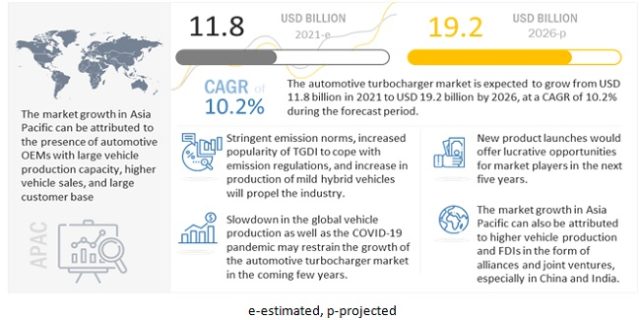
The Automotive Turbocharger Market is projected to reach $19.2 billion by 2026 from
$11.8 billion in 2021, at a CAGR of 10.2% during the forecast period.
Stringent emission norms and increasing adoption of TGDI (Turbocharged Gasoline Direct Injection) technology will drive the automotive turbocharger market.
Key Players in Automotive Turbocharger Market:
Honeywell (US), BorgWarner (US), MHI (Japan), IHI (Japan), Continental (Germany), Bosch Mahle (Germany), Cummins (US), ABB (Switzerland), TEL (India), and Delphi Technologies (UK), Rotomaster International (Canada), Precision Turbo & Engine INC(US), Turbonetics(US), Turbo International (US), Kompressorenabu Bannewitz GMBH(Germany), Turbo Dynamic Ltd.(UK), Fuyuan Turbocharger Co. Ltd.(China), Hunan Tyen Machinery Co. Ltd. (China), Ningbo Motor Industrial Co. Ltd. (China), Calsonic Kansei (Japan).
The passenger car segment is estimated to be the largest and the fastest-growing market for automotive turbochargers because of the higher production of passenger cars than commercial vehicles.
Asia Pacific region is expected to be the largest market. The growth can be attributed to the improving socio-economic conditions in emerging economies such as China, India, Indonesia, and Thailand. The increased vehicle production and upcoming stringent emission norms in China and India will boost the automotive turbocharger market.
Request FREE Sample Report @ https://www.marketsandmarkets.com/requestsampleNew.asp?id=919
Regarding light-weighting, like most of the other components, the turbocharger industry is also shifting towards light-weighting. The demand for aluminium for turbocharger components is expected to showcase the fastest demand in the near future. Regarding turbocharger technology – presently, owing to their low cost, as compared with VGT/VNT, the wastegate type is dominating the global turbochargers market. These turbo types are more preferred in developing countries where economical cars are preferred. However, with advancements in technologies and an increase in preference towards high powered vehicles, the demand for VGT/VNT type is projected to showcase the fastest growth in the near future.
In the present study published by MarketsandMarkets, the off-highway vehicle turbocharger market includes agricultural tractors and construction equipment. Owing to increased infrastructure development, emerging economies, mining activities, the construction equipment demand is projected to grow at a faster rate. Hence, the construction equipment turbocharger market is estimated as the most rapid market. The study also estimates that penetration of turbochargers in high HP agriculture tractors is more, whereas, in low HP tractors, it is negligible. As the high HP tractors are more preferred in western countries, the demand for tractor turbochargers is projected to be more in western countries as compared with developing countries from Asia.
Looking at the upcoming regulations and increased preference towards high powered vehicles, the manufacturers can focus on the development of electric turbochargers, whereas, in terms of the type, the manufacturers can look forward to increasing demand for gasoline VGT/VNT. The turbocharger manufacturers can also focus on changes in material, where aluminium and nickel alloys are replacing the traditional cast iron. The critical components like turbines and compressors which are exposed to the extreme environment would potentially have the demand for these materials in the near future.
Download PDF Brochure @ https://www.marketsandmarkets.com/pdfdownloadNew.asp?id=919
Automotive Turbocharger Market Key Application:
- Variable geometry turbocharger (VGT/VNT) – Variable geometry turbocharger is also known as variable nozzle turbocharger (VNT). In variable geometry turbocharger, the flow of exhaust gas is adjusted automatically according to the speed and the load of the engine, which helps in reducing fuel consumption. The VGT technology has helped to overcome the limitation set by fixed geometry turbocharger (FGT)/wastegate turbocharger. Variable geometry turbochargers have a different configuration, which consists of directing the exhaust through vanes after the turbine, making it more effective and performance-oriented than wastegate.
- Wastegate turbocharger – A wastegate turbocharger is a device that controls maximum boost by bypassing exhaust flow around the turbine section of a turbocharger. Wastegate turbocharger is used to prevent over boost of the engine, which occurs in peak torque conditions, with the help opening and closing valve during maximum torque. Wastegate turbochargers do not have movable vanes due to which the price is lesser than the price of variable geometry turbocharger. Wastegate turbochargers are becoming extremely popular in small cars.
- Electric turbocharger – Electric turbocharger is an advanced technology in turbocharging used in internal combustion engines with hybrid powertrains. An electric turbocharger can be operational only with 48V architecture. The benefit of the electric turbocharger is that it does not have turbo lag. This reduces emissions and improves fuel efficiency.